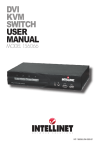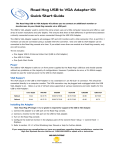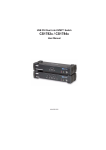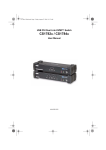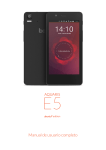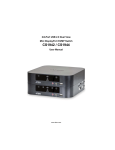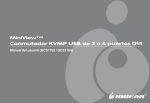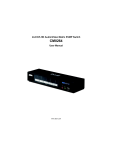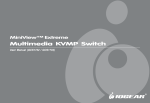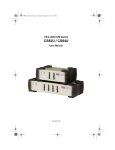Download Installation Guide
Transcript
Installation Guide 4 Port Dual-Link DVI KVMP Pro GCS1204G 1 Part No. M1170 Table of Contents Conventions 4 Troubleshooting 36 Package Contents 5 Specifications 37 Requirements 6 39 Operating Systems 7 Federal Communications Commission (FCC) Statement CE Statement 40 Contact 41 Warranty 42 Hardware Setup 12 Basic Operation 14 Port ID Numbering 17 Advanced Configuration 21 Summary of Hotkey Settings 23 Comparison of Default and Alternate Manual Port Selection Settings 26 Keyboard Operating Platform 27 The Firmware Upgrade Utility 32 3 Conventions This manual uses the following conventions: Monospaced Indicates text that you should key in. [ ] Indicates keys you should press. For example, [Enter] means to press the Enter key. If keys need to be chorded, they appear together in the same bracket with a plus sign between them: [Ctrl+Alt]. 1. Numbered lists represent procedures with sequential steps. • Bullet lists provide information, but do not involve sequential steps. ––> Indicates selecting the option (on a menu or dialog box, for example), that comes next. For example, Start ––> Run means to open the Start menu, and then select Run. Indicates critical information. 4 Package Contents 1- USB 2.0 DVI KVMP Switch 4- Custom KVM Cable Sets (6 ft) 1- USB-to-PS/2 Converter 1- Power Adapter 1- User Manual 1- Warranty Card Verify all the components are present and that nothing was damaged in shipping. If you encounter a problem, contact your dealer, or IOGEAR. Read this manual thoroughly and follow the installation and operation procedures carefully to prevent any damage to the unit, and / or any of the devices connected to it. 5 Requirements USB mouse USB keyboard Microphone and speakers (optional) Monitor with a DVI input. Computers A DVI-D port USB Type A port Audio ports (optional) 6 Operating Systems OS Flavor Windows Linux Unix Novell Version 2000 and higher RedHat 9.0 and higher SuSE 10.0 / 11.1 and higher Ubutu 7.04 / 7.10 AIX 4.3 and higher FreeBSD 5.5 and higher Sun Solaris 9 and higher Netware 6.0 and higher MAC OS 9.0 and higher Note: Supports Linux Kernel 2.6 and higher. 7 Components 1 4-Port Dual-Link DVI KVMP Switch 2 8 3 4 No. Component Description 1 Port Select Pushbuttons Press a port button for longer than two seconds to bring the KVM, USB, and audio focus to the computer attached to its corresponding port. 2 Port LEDs The Port LEDs are located below the Port selection buttons The upper ones are the KVM port LEDs and the lower are the USB LEDs KVM: Lights Dim Orange to indicate the computer attached to the port is on line. It changes to bright Orange when the port is selected and flashes to indicate auto scan has been activated. USB: Lights dim green to indicate a USB connection. It changes to bright Green to indicate to indicate the KVM is focused on the port 3 Console Ports Audio The connections for your main console microphone and speakers. These audio ports have priority over the ports in the rear panel. 4 USB 2.0 Peripheral Port One of the two USB 2.0 peripheral ports. It is backwards compatible with USB 1.0 9 4-Port Dual-Link DVI KVMP Switch Rear View 1 4 3 2 5 10 No. Component Description 1 USB Console Ports USB Keyboard and mouse connections 2 Console Port Section Monitor, mic, and speaker connections 3 CPU Port Section Connections for the cables that link the switch to your computers. Each CPU port is comprised of a microphone jack, speaker jack, USB type B socket and a DVI connector 4 Power Jack Power adapter connection 5 USB Peripheral Port Connection for USB 2.0 peripherals ( printers, scanners, etc) 11 Hardware Setup Make sure that power to all the devices you will be installing has been turned off. You must unplug the power cords of any computers that have the Keyboard Power On function. Cable Connection To install your GCS1204, refer to the diagram on the following page. The numbers in the diagrams correspond to the steps below. 1. Connect your USB keyboard and mouse into the USB Console Ports located on the unit’s rear panel. 2. Connect your microphone, speakers, and monitor into the Console ports located on the unit’s rear panel 3. Using the KVM cables, connect the DVI connector to a DVI socket in the CPU Port section of the switch, then connect the accompanying USB, microphone and speaker connectors to their corresponding USB, microphone, and speaker sockets. 4. At the other end of the cable, connect the USB, video, microphone, and speaker cables to their respective ports on the computer. 5. Connect your USB peripherals to the type A sockets (one is located on the front, the other is located on the rear of the unit). 6. Connect the power adapter that came with your switch to the jack on the switch then connect the adapter to an AC power source. 12 7. Verify your connections: ports are correct and icons match the connection type i.e. mouse and mouse icon 4-Port Dual-Link DVI KVMP Switch 8. Power on the computers. 5 1 2 3 4-Port Dual-Link DVI KVMP Switch 6 5 2 1 5 2 3 4 13 6 2 5 Basic Operation There are three convenient methods to access the computers: Manual – which involves pressing the port selection buttons located on the unit’s front panel; Mouse – which involves double clicking the scroll wheel of the mouse; and Hotkey – which involves entering key combinations from the keyboard. Manual port selection Press and release a port selection button to focus the computer on the corresponding port. The USB and Audio focus do not change (expect a 2 sec delay). Press a port selection button twice to focus the audio on the corresponding port (expect a 2 sec delay). Press and hold a port selection button for more than 2 seconds to change KVM, USB, and Audio focus to the computer on the selected port. Press and hold port selection buttons 1 and 2 for more than 2 seconds to start Auto Scan Mode. 14 Mouse Port Switching The KVM supports the very latest in mouse port-switching – simply double-click the scroll wheel of your USB mouse to cycle through the ports. Note: 1. This featured is only supported by USB 3-key scroll wheel mice. 2. The default setting is disabled. 3. This feature is only supported when Mouse Emulation is enabled. See Mouse Emulation Control for details Hotkey switching All port switching begins by tapping the Scroll Lock key twice. The tables below describe the actions that each combination performs. Note: If the Scroll Lock key conflicts with programs running on the computer, or your keyboard does not have a Scroll Lock, see the section titled Advanced Switching to use the alternate switching method. 15 Cycling though the ports Hotkey Action [Scroll Lock] [Scroll Lock] [Enter] Increments the KVM, USB, and Audio focus to the next higher port ( port 4 wraps to 1) [Scroll Lock] [Scroll Lock] [K] [Enter] Increments only KVM focus to the next port [Scroll Lock] [Scroll Lock] [U] [Enter] Increments only the USB hub to the next port [Scroll Lock] [Scroll Lock] [S] [Enter] Increments only Audio to the next port * The USB ports cannot be switched independently of each other. 16 Port ID Numbering Each CPU port on the GCS1204 is assigned a port number (1, 2, 3, or 4). The port numbers are marked on the rear panel of the switch and each switch LED has a corresponding number for easy identification The Port ID of a computer is derived from the CPU port number to which it is connected. For example, a computer connected to CPU port 2 has a Port ID of 2. The Port ID is used to specify which computer gets the KVM, USB peripheral, and / or audio focus with the Hotkey port selection method Going Directly to a Port Note: The n stands for the computer’s Port ID number. Replace the n with the appropriate Port ID when entering hotkey combinations 17 Hotkey Action [Scroll Lock] [Scroll Lock][n][Enter] Brings the KVM, USB hub, and audio focus to the computer attached to the specified port. [Scroll Lock] [Scroll Lock][n] [K] Enter] Brings only the KVM focus to the computer attached to the specified port. [Scroll Lock] [Scroll Lock] [n] [U] [Enter] Brings only the USB hub focus to the computer attached to the specified port. [Scroll Lock] [Scroll Lock] [n] [S] [Enter] Brings only the audio focus to the computer attached to the specified port. [Scroll Lock] [Scroll Lock] [n] [K] [U] [Enter] Brings the KVM and USB hub focus to the computer attached to the specified port [Scroll Lock] [Scroll Lock] [n] [K] [S] [Enter] Brings the KVM and audio focus to the computer attached to the specified port. [Scroll Lock] [Scroll Lock] [n] [U] [S] [Enter] Brings the USB hub and audio focus to the computer attached to the specified port. 18 Auto Scanning The GCS1204’s Auto Scan feature automatically cycles KVM focus through the computer ports at regular intervals. This allows you to monitor computer activity without having to switch from port to port manually. Note: 1. n stands for the number of seconds the GCS1204 will dwell on a port before moving on to the next. Replace n with a number between 1 and 99 when entering the hotkey combination. 2. While Auto Scan Mode is in effect, ordinary keyboard and mouse functions are suspended – only Auto Scan Mode compliant keystrokes and mouse clicks can be input. You must exit Auto Scan Mode in order to regain normal control of the console (hit the space bar or the Esc key). 3. Although the video focus switches from port to port, the keyboard, mouse, and USB focus remain on the port where Auto Scanning began. 19 Hotkey Action [Scroll Lock] [Scroll Lock] [A] Enter] Invokes Auto Scan. The KVM focus cycles from port to port at 5 second intervals (default interval) [Scroll Lock] [Scroll Lock] [A] [N] Enter] The KVM focus cycles from port to port at N seconds interval 20 Advanced Configuration Advanced Switching Hotkey Setting Mode In some instances the default hotkey settings conflict with programs running on your computer, and in some instances the default hotkeys either do not exist on your keyboard (MAC keyboards for instance do not have a Scroll Lock key), or are inconvenient to use, so The Hotkey Setting Mode allows you to select alternate configurations for the KVM’s hotkeys. When HSM is active, the Caps Lock, and Scroll Lock LEDs flash in succession to indicate that HSM is in effect. They stop flashing and revert to normal status when you exit HSM. Ordinary keyboard and mouse functions are suspended – only Hotkey compliant keystrokes (described in the sections that follow), can be input. At the conclusion of some hotkey operations, you automatically exit hotkey mode. With some operations, you must exit manually. To exit HSM manually, press the Esc key, or the Spacebar. 21 Invoking Hotkey Setting Mode (Default) 1. Press and hold down [Num Lock] (the Clear key on MAC keyboards). 2. Press and release [-]. 3. Release [Num Lock] (the Clear key on MAC keyboards). To Toggle to the alternate Hotkey Setting Mode (HSM): 1. Press and hold down [Num Lock] (the Clear key on MAC keyboards) 2. Press and release [-]. 3. Release [Num Lock] (the Clear key on MAC keyboards) 4. Press and release [H]. Invoking Hotkey Setting Mode (Alternate) 1. Press and hold down [Ctrl]. 2. Press and release [F12]. 3. Release [Ctrl]. 22 Summary of Hotkey Settings NOTE: The term “invoke HSM” in the following table refers to the default or alternate method chosen above Action Key sequence result Port Switching Invoke HSM Press Changes the [Scroll Lock] key to [Ctrl] and release [T] USB reset Resets the USB peripheral ports 1. Invoke HSM. 2. Press and release [F5] Restore Default Settings Reset the KVM to its default hotkey settings 1. Invoke HSM. 2. Press [R] [Enter]. Hotkey Beeper Control 1. Invoke HSM. Disable Port Switching Hot Keys 1. Invoke HSM Toggles the Beeper On and Off 2. Press [B] Toggles Hotkey Switching on or off 2. Press [X] [Enter] 23 Other OS Mode 1. Invoke HSM 2. Press [F1] Reset keyboards and mice under some special OS’s that do not support USB 2.0 Mouse Emulation Control 1. Invoke HSM 2. Press [M] Allows the special programming of multifunction mice to operate through the KVM List Hotkey Settings 1. Open a word processor 2. Invoke HSM. 3. Press and release [F4] Prints a list of the current hotkey settings in your text editor or word processor Display Emulation Technology 1. Invoke HSM 2. Press and release [D] Display Emulation Technology eliminates the problems of your display reverting to default resolution when switching between computers, or displaying a default resolution if the KVM is not focused on the computer while it is booting. Alternative Manual Port Selection Settings 1. Invoke HSM 2. Press and release [S] Toggles between the default and the alternative front panel pushbutton port selection settings See the table on page 26 for comparisons 24 Mouse Portswitching 1. Invoke HSM 2. Press [W] The Mouse Port-switching function can be enabled or disabled. The default setting is disabled. Note: This feature only supports the USB 3-key scroll wheel mice. The default setting is OFF. This feature is only supported when mouse emulation is also enabled. See Mouse Emulation Control, above. Keyboard Emulation Control 1. Invoke HSM 2. Press [N] Console keyboard port emulation/bypass feature supports most gaming/multimedia keyboards. The default setting is enabled. Disabling allows the special keyboard commands to pass through the KVM to the computer. Note: When keyboard emulation is disabled, the following Hotkeys are disabled. [M], [W], [F2], [F3], [F4], [F5], [F6], and [F10] See page 28, for details. Firmware Upgrade Mode 1. Invoke HSM 2. Key in: upgrade 3. Press [Enter] The orange front panel LEDs flash to indicate Firmware Upgrade Mode is in effect. 25 Comparison of Default and Alternate Manual Port Selection Settings Action Default Alternate Press and release a port selection button Switches only the KVM focus to the selected port KVM, Audio and USB focus switch to the selected port Press a port selection button twice Audio focus switches to the selected port Audio focus switches to the selected port Press and hold a port selection button for more than 2 seconds KVM focus, USB, and Audio focus switch to the selected port Switches only the KVM focus to the selected port Press and hold port selection buttons 1 and 2 for more than 2 seconds Starts AutoScan at 5 sec dwell Starts AutoScan at 5 sec dwell 26 Keyboard Operating Platform Keyboard Operating Platform The KVM’s default port configuration is for a PC compatible keyboard. If you are using a PC compatible keyboard and you have a Mac or Sun attached to a port, you can change the port’s keyboard operating platform configuration to emulate a Mac or Sun keyboard. 1. Bring the KVM focus to the port you want to set. 2. Invoke HSM. 3. Press and release the appropriate Function key (see table below). Function Key Operation [F2] Enables Mac keyboard emulation, see Mac Keyboard Emulation, [F3] Enables Sun keyboard emulation, see Sun Keyboard Emulation [F10] Disables keyboard emulation. Key presses are passed straight through. When your console uses a Mac keyboard to access a Mac attached to a port, for example After completing this procedure, you automatically exit HSM. The PC compatible (101/104 key) keyboard can emulate the functions of Mac and Sun keyboards when the Control key [Ctrl] is used in conjunction with other keys. The emulation mappings are listed in the table on the next page. 27 PC Keyboard Mac Keyboard [Shift] Shift [Ctrl] Ctrl [Ctrl] [1] [Ctrl] [2] [Ctrl] [3] [Ctrl] [4] [Alt] Alt 28 PC Keyboard Mac Keyboard [Print Screen] F13 [Scroll Lock] F14 = [Enter] Return [Backspace] Delete [Insert] Help [Ctrl] F15 29 PC Keyboard Sun Keyboard [Ctrl] [T] Stop [Ctrl] [F2] Again [Ctrl] [F3] Props [Ctrl] [F4] Undo [Ctrl] [F5] Front [Ctrl] [F6] Copy [Ctrl] [F7] Open [Ctrl] [F8] Paste [Ctrl] [F9] Find 30 PC Keyboard Sun Keyboard [Ctrl] [F10] Cut [Ctrl] [1] [Ctrl] [2] [Ctrl] [3] [Ctrl] [4] [Ctrl] [H] Help Compose Note: Press and release the first key [Ctrl], then press and release the activation key. 31 The Firmware Upgrade Utility The Windows-based Firmware Upgrade Utility provides a smooth, automated process for upgrading the KVM switch’s firmware. The Utility comes as part of a Firmware Upgrade Package that is specific for each device. Check the web site regularly to find the latest packages and information relating to them: http:// www.iogear.com Before you Begin 1. From a computer that is not part of your KVM installation go to our website site support section and choose the model name that relates to your device to get a list of available Firmware Upgrade Packages. 2. Choose the Firmware Upgrade Package you want to install (usually the most recent), and download it to your computer. 3. Power off the switch. Unplug the KVM cables from the back of the switch. If you are using a power adapter, unplug it and remove its connector from the switch’s power jack. Connect one of the USB DVI KVM cable set’s Type A USB connectors to a USB hub port on your computer. 4. At the other end of the USB DVI KVM cable set, connect the USB Type B connector to the Type A USB port in the Port 1 KVM section. Note: The USB DVI KVM cable set’s USB Type B connector can be connected to any USB Type KVM port section, but the Port selection pushbutton in Step 5, below, must be Port 1. 32 5. Invoke Firmware Upgrade Mode (see Firmware Upgrade Mode, page 25). The front panel orange LEDs flash to indicate that Firmware Upgrade Mode is in effect. 3 4 33 Starting the Upgrade 1. Run the downloaded Firmware Upgrade Package file – either by double clicking the file icon, or using a command line to enter the full path. The Firmware Upgrade Utility Welcome screen appears: 2. Read the License Agreement (click the I Agree button). 3. Click Next. The Firmware Upgrade Utility main screen appears. The Utility inspects your installation. All the devices capable of being upgraded by the package are listed in the Device List panel. 4. As you select a device in the list, its description appears in the Device Description panel. After you have made your device selection(s), Click Next to perform the upgrade. If you enabled Check Firmware Version, the Utility compares the device’s firmware level with that of the upgrade files. If the device’s version is higher than the upgrade version, a dialog box gives you the option to Continue or Cancel. If you didn’t enable Check Firmware Version, the Utility installs the upgrade files without checking whether they are a higher level, or not. 34 Upgrade Succeeded After the upgrade has completed, a screen appears to inform you that the procedure was successful: Click Finish to close the Firmware Upgrade Utility. After a successful completion, the KVM exits Firmware Upgrade Mode, and resets itself. Upgrade Failed If the Upgrade Succeeded screen doesn’t appear, it means that the upgrade failed to complete successfully, in which case you should do the following: 1. Power off the KVM by removing the power jack. 2. Invoke Firmware Upgrade Mode by holding down the Port 1 button on the front panel and power on the KVM. The orange LEDs will flash together. 3. Do the firmware upgrade procedure again. 35 Troubleshooting Symptom Possible Cause Action Mouse / Keyboard not responding. Improper mouse Unplug the cable(s) from the console port(s), and/or keyboard reset. then plug it/them back in. KVM switch Power off all devices on the installation. needs to be reset. Power off the KVM switch; wait five seconds; then power up USB devices USB ports not responding. need to reset. Unplug the device’s USB cable from the USB port on the switch’s rear panel, then plug it back in. PC or OS does not support USB 2.0. There are ghost images on the external monitor. The GCS1204 has a built-in USB 2.0 hub, so will not support PCs or OS that do not support USB 2.0. The distance between the external console and the GCS1204 is too great. The maximum VGA cable distance should not exceed 20m and, in some cases, may need to be shorter. Replace the VGA cable with one of an appropriately short length. 36 Specifications Function GCS1204G Computer Connections 4 CPU Port Selection Front Panel Pushbuttons; Hotkey Console Connectors Keyboard 1 x USB Type A F (black, rear panel) Mouse 1 x USB Type A F (black, rear panel) Video 1 x DVI-I F (white) Audio* Line in Port 2x Mini Stereo Jack (green; 1 x front panel, 1 x rear panel) Microphone Port 2x Mini Stereo Jack (pink; 1 x front panel, 1 x rear panel) Power Consumption DC 5.3V, 4.8W Computer Connectors KB / USB X 2 37 Mouse Switches LEDs Video Dual Link DVI Power 1 USB Hub 2 4 ea Port Selection 4 Green 4 Orange 38 Federal Communications Commission (FCC) Statement This equipment has been tested and found to comply with the limits for a Class B digital device, pursuant to Part 15 of the FCC Rules. These limits are designed to provide reasonable protection against harmful interference in a residential setting. This product generates, uses, and can radiate radio frequency energy and, if not installed and used as directed, it may cause harmful interference to radio communications. Although this product complies with the limits for a Class B digital device, there is no guarantee that interference will not occur in a particular installation. 39 CE Statement This device has been tested and found to comply with the following European Union directives: Electromagnetic Capability (89/336/EMC), Low Voltage (73/23/EEC) and R&TTED (1999/5/EC). 40 Contact IOGEAR, INC. 19641 Da Vinci Foothill Ranch, CA 92610 P 949.453.8782 F 949.453.8785 Visit us at: www.iogear.com © 2011 IOGEAR All Rights reserved. Part No. M1170 IOGEAR, the IOGEAR logo, are trademarks or registered trademarks of IOGEAR, Inc. Microsoft and Windows are registered trademarks of Microsoft Corporation. All other brand and product names are trademarks or registered trademarks of their respective holders. IOGEAR makes no warranty of any kind with regards to the information presented in this document. All information furnished here is for informational purposes only and is subject to change without notice. IOGEAR, Inc. assumes no responsibility for any inaccuracies or errors that may appear in this document. 41 Warranty WE’RE HERE TO HELP YOU! NEED ASSISTANCE SETTING UP THIS PRODUCT? Make sure you: 1. Use the live chat at www.iogear.com to try and solve any issues you may be having with the product 2. Visit the Tech Info Library/FAQ on www.iogear.com (under the Support tab) 3. Call the support line at 1(866) 946-4327 (U.S. only) or (949) 453-8782 Warranty Information This product carries a 3 Year Limited Warranty. For the terms and conditions of this warranty, please go to http://www.iogear.com/support/warranty or call 1-866-946-4327 Register online at http://www.iogear.com/register Important Product Information Product Model _________________ Serial # _______________________ 42 About Us FUN IOGEAR offers connectivity solutions that are innovative, fun, and stylish, helping people enjoy daily life using our high technology products. GREEN IOGEAR is an environmentally conscious company that emphasizes the importance of conserving natural resources. The use of our technology solutions helps reduce electronic waste. © 2011 IOGEAR













































